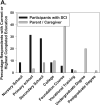Pediatric health and life domain priorities: A national survey of people with spinal cord injury and their parents and caregivers
- PMID: 35776093
- PMCID: PMC10795593
- DOI: 10.1080/10790268.2022.2087140
Pediatric health and life domain priorities: A national survey of people with spinal cord injury and their parents and caregivers
Abstract
Context/objective: No information is available regarding priorities for pediatric-onset spinal cord injury (SCI). This study described the Health and Life (H&L) domain priorities of youth with pediatric-onset SCI and their parents/caregivers living in Spain.
Design: A cross-sectional survey.
Setting: Two SCI rehabilitation centers.
Participants: Sixty participants, youth with pediatric-onset SCI (n = 26) and parents/caregivers (n = 34).
Interventions: Not applicable.
Outcome measures: Median overall priorities calculated on the basis of importance, unhappiness, and research measured with a new survey of pediatric H&L domains and rated using a 5-point Likert Scale.
Results: A total of 60 surveys were received providing information on 35 individuals with SCI: 2-7-year-olds (25.7%), 8-12-year-olds (22.9%), 13-17-year-olds (31.4%), and 18-25-year-olds (20.0%). The top three overall H&L priorities reported by parents/caregivers of 2-12-year-olds were "parenthood expectations" (84%), "leg/foot movement" (83%), and "bladder" function (83%), compared to "dressing/undressing" (78%), "walking/ability to move" (77%) and "bladder" function (77%) rated for 13-25-year-olds. "Sit-to-stand" (79%), "leg/foot movement" (78%) and "arm/hand movement" (77%) were reported as priorities by 13-25-year-olds. The 13-25-year-olds highlighted "sit-to-stand" (100%), "eating/drinking" (54%), and "physical function" (94%) as their top unhappiness, importance, and research priorities, respectively. Significant differences between tetraplegia and paraplegia were found in "mobility in the community" (unhappiness item) for 13-25-years-old.
Conclusion: Health domains were considered the top overall H&L priorities by parents/caregivers of 13-25-year-olds, compared to life domains reported for their 2-12-year-olds. This survey will aid rehabilitation professionals to engage stakeholders to implement a comprehensive SCI management program for the pediatric population.
Keywords: Adolescent; Child; Life and health priorities; Rehabilitation; Spinal cord injuries.
Figures




References
-
- Canosa-Hermida E, Mora-Boga R, Cabrera-Sarmiento JJ, Ferreiro-Velasco ME, la Barrera S S-d, Rodríguez-Sotillo A, Montoto-Marqués A.. Epidemiology of traumatic spinal cord injury in childhood and adolescence in galicia. Spain: report of the last: 26-years. J Spinal Cord Med 2019;42:423–429. doi:10.1080/10790268.2017.1389836. Cited in: PMID: 29058557. - DOI - PMC - PubMed
Publication types
MeSH terms
LinkOut - more resources
Full Text Sources
Other Literature Sources
Medical
